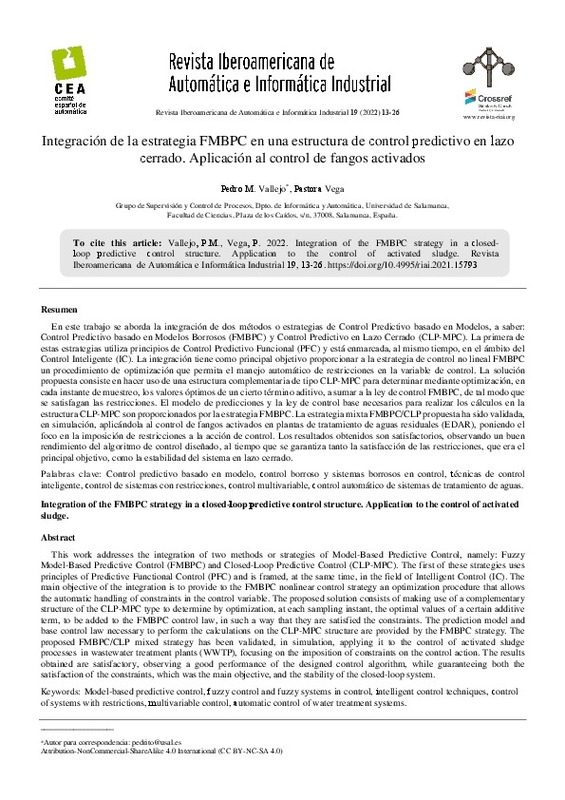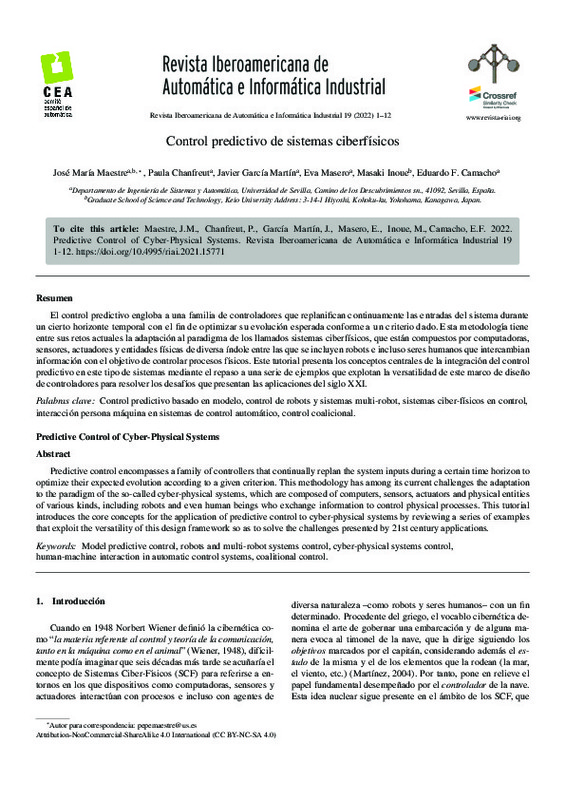JavaScript is disabled for your browser. Some features of this site may not work without it.
Buscar en RiuNet
Listar
Mi cuenta
Estadísticas
Ayuda RiuNet
Admin. UPV
Coeficientes de la superficie en modo deslizante directamente en la magnitud de control, un enfoque de esfuerzo reducido
Mostrar el registro sencillo del ítem
Ficheros en el ítem
| dc.contributor.author | Acosta Cano de los Ríos, Pedro
|
es_ES |
| dc.contributor.author | Robledo-Vega, Isidro
|
es_ES |
| dc.contributor.author | Rodríguez-Mata, Abraham E.
|
es_ES |
| dc.contributor.author | Baray-Arana, Rogelio
|
es_ES |
| dc.date.accessioned | 2023-11-07T13:14:43Z | |
| dc.date.available | 2023-11-07T13:14:43Z | |
| dc.date.issued | 2023-09-29 | |
| dc.identifier.issn | 1697-7912 | |
| dc.identifier.uri | http://hdl.handle.net/10251/199438 | |
| dc.description.abstract | [EN] A design procedure is presented for first order sliding mode control applied to a system in form of a pure or perturbed chain of integrators (perturbed controllable canonical form). The control law is proposed in a novel way. The control magnitude is directly defined by the sliding surface polynomial coefficients. It is shown that this procedure minimizes in a given sense the control effort for reaching the designed surface. Calculations are even simpler than those in sliding mode classical techniques. Moreover, choosing a stable dynamical surface warranties a finite reaching time to it. Control effort and chattering are low. Under given conditions of the surface reaching phase, advantage is taken of known perturbations and terms leading to instability. Simulations are given illustrating the results and comparing the behavior of some sliding mode methods in the literature to the one here proposed. | es_ES |
| dc.description.abstract | [ES] Se presenta un procedimiento de diseño para el control en modo deslizante de primer orden aplicado a un sistema en forma de cadena de integradores pura o perturbada, (forma canónica controlable perturbada). La ley de control se propone de forma novedosa. La magnitud de control se define directamente por los coeficientes del polinomio de la superficie de deslizamiento. Se muestra que este procedimiento minimiza en cierto sentido el esfuerzo de control para alcanzar la superficie diseñada. Los cálculos son aún más sencillos que los de las técnicas clásicas en modo deslizante. Además, la elección de una dinámica de superficie estable garantiza un tiempo de alcance finito a la misma. El esfuerzo de control y el castañeteo (chattering) son bajos. Las perturbaciones y términos conocidos que provocan inestabilidad se aprovechan en ciertas condiciones del alcance a la superficie. Se presentan simulaciones que ilustran los resultados y comparando el comportamiento de métodos de control en modo deslizante existentes en la literatura con el propuesto en este artículo. | es_ES |
| dc.language | Español | es_ES |
| dc.publisher | Universitat Politècnica de València | es_ES |
| dc.relation.ispartof | Revista Iberoamericana de Automática e Informática industrial | es_ES |
| dc.rights | Reconocimiento - No comercial - Compartir igual (by-nc-sa) | es_ES |
| dc.subject | Control effort | es_ES |
| dc.subject | Chain of integrators | es_ES |
| dc.subject | Perturbation rejection | es_ES |
| dc.subject | Chattering | es_ES |
| dc.subject | Control en modo deslizante | es_ES |
| dc.subject | Cadena de integradores | es_ES |
| dc.subject | Rechazo a perturbaciones | es_ES |
| dc.subject | Castañeteo | es_ES |
| dc.subject | Esfuerzo de control | es_ES |
| dc.subject | Sliding mode control | es_ES |
| dc.title | Coeficientes de la superficie en modo deslizante directamente en la magnitud de control, un enfoque de esfuerzo reducido | es_ES |
| dc.title.alternative | Sliding mode surface coefficients directly in the control magnitude, a reduced effort approach | es_ES |
| dc.type | Artículo | es_ES |
| dc.identifier.doi | 10.4995/riai.2023.17980 | |
| dc.rights.accessRights | Abierto | es_ES |
| dc.description.bibliographicCitation | Acosta Cano De Los Ríos, P.; Robledo-Vega, I.; Rodríguez-Mata, AE.; Baray-Arana, R. (2023). Coeficientes de la superficie en modo deslizante directamente en la magnitud de control, un enfoque de esfuerzo reducido. Revista Iberoamericana de Automática e Informática industrial. 20(4):355-365. https://doi.org/10.4995/riai.2023.17980 | es_ES |
| dc.description.accrualMethod | OJS | es_ES |
| dc.relation.publisherversion | https://doi.org/10.4995/riai.2023.17980 | es_ES |
| dc.description.upvformatpinicio | 355 | es_ES |
| dc.description.upvformatpfin | 365 | es_ES |
| dc.type.version | info:eu-repo/semantics/publishedVersion | es_ES |
| dc.description.volume | 20 | es_ES |
| dc.description.issue | 4 | es_ES |
| dc.identifier.eissn | 1697-7920 | |
| dc.relation.pasarela | OJS\17980 | es_ES |
| dc.description.references | Acosta, P., 2014. Natural surface design for sliding mode control with multiple discontinuous inputs. Journal of the Franklin Institute 351 (8), 4198-4210. https://doi.org/10.1016/j.jfranklin.2014.04.023 | es_ES |
| dc.description.references | Adelipour, S., Ahi, B., Haeri, M., 2020. Dual-mode global stabilization of highorder saturated integrator chains: Lmi-based mpc combined with a nested saturated feedback. Nonlinear Dynamics 102 (1), 211-222. https://doi.org/10.1007/s11071-020-05957-0 | es_ES |
| dc.description.references | Amini, S., Ahi, B., Haeri, M., 2019. Control of high order integrator chain systems subjected to disturbance and saturated control: A new adaptive scheme. Automatica 100, 108-113. https://doi.org/10.1016/j.automatica.2018.10.039 | es_ES |
| dc.description.references | Bartolini, G., Pydynowski, P., 1996. An improved, chattering free, vsc scheme for uncertain dynamical systems. IEEE Transactions on Automatic Control 41 (8), 1220-1226. https://doi.org/10.1109/9.533691 | es_ES |
| dc.description.references | Chalanga, A., Kamal, S., Bandyopadhyay, B., 2014. A new algorithm for continuous sliding mode control with implementation to industrial emulator setup. IEEE/ASME Transactions on Mechatronics 20 (5), 2194-2204. https://doi.org/10.1109/TMECH.2014.2368717 | es_ES |
| dc.description.references | Chitour, Y., Ushirobira, R., Bouhemou, H., 2020. Stabilization for a perturbed chain of integrators in prescribed time. SIAM Journal on Control and Optimization 58 (2), 1022-1048. https://doi.org/10.1137/19M1285937 | es_ES |
| dc.description.references | Fridman, L., Moreno, J. A., Bandyopadhyay, B., Kamal, S., Chalanga, A., 2015. Continuous nested algorithms: The fifth generation of sliding mode. https://doi.org/10.1007/978-3-319-18290-2_2 | es_ES |
| dc.description.references | Hong, Y., 2002. Finite-time stabilization and stabilizability of a class of controlable systems. Systems & control letters 46 (4), 231-236. https://doi.org/10.1016/S0167-6911(02)00119-6 | es_ES |
| dc.description.references | Hong, Y., Yang, G., Cheng, D., Spurgeon, S., 2005. A new approach to terminal sliding mode control design. Asian Journal of Control 7 (2), 177-181. https://doi.org/10.1111/j.1934-6093.2005.tb00386.x | es_ES |
| dc.description.references | Hu, J., Zhang, H., Liu, H., Yu, X., 2021. A survey on sliding mode control for networked control systems. International Journal of Systems Science 52 (6), 1129-1147. https://doi.org/10.1080/00207721.2021.1885082 | es_ES |
| dc.description.references | Kamal, S., Bandyopadhyay, B., 2012. Arbitrary higher order sliding mode control based on control lyapunov approach. En: 2012 12th International Workshop on Variable Structure Systems. IEEE, pp. 446-451. https://doi.org/10.1109/VSS.2012.6163543 | es_ES |
| dc.description.references | Laghrouche, S., Harmouche, M., Chitour, Y., 2017. Higher order super-twisting for perturbed chains of integrators. IEEE Transactions on Automatic Control 62 (7), 3588-3593. https://doi.org/10.1109/TAC.2017.2670918 | es_ES |
| dc.description.references | Levant, A., 1993. Sliding order and sliding accuracy in sliding mode control. International journal of control 58 (6), 1247-1263. https://doi.org/10.1080/00207179308923053 | es_ES |
| dc.description.references | Levant, A., 2001. Universal single-input-single-output (siso) sliding-mode controllers with finite-time convergence. IEEE transactions on Automatic Control 46 (9), 1447-1451. https://doi.org/10.1109/9.948475 | es_ES |
| dc.description.references | Liu, X., Han, Y., 2014. Finite time control for mimo nonlinear system based on higher-order sliding mode. ISA transactions 53 (6), 1838-1846. https://doi.org/10.1016/j.isatra.2014.09.002 | es_ES |
| dc.description.references | Plestan, F., Glumineau, A., Laghrouche, S., 2008. A new algorithm for highorder sliding mode control. International Journal of Robust and Nonlinear Control: IFAC-Affiliated Journal 18 (4-5), 441-453. https://doi.org/10.1002/rnc.1234 | es_ES |
| dc.description.references | Riaz, U., Tayyeb, M., Amin, A. A., 2021. A review of sliding mode control with the perspective of utilization in fault tolerant control. Recent Advances in Electrical & Electronic Engineering (Formerly Recent Patents on Electrical & Electronic Engineering) 14 (3), 312-324. https://doi.org/10.2174/2352096513999201120091512 | es_ES |
| dc.description.references | Ullah, N., Ali, M. A., Ibeas, A., Herrera, J., 2019. Control deslizante fraccionario de la trayectoria y orientación de un quadrotor con cargas suspendidas desconocidas. Revista Iberoamericana de Automática e Informática industrial 16 (3), 321-331. https://doi.org/10.4995/riai.2019.9951 | es_ES |
| dc.description.references | Utkin, V., 2015. Discussion aspects of high-order sliding mode control. IEEE Transactions on Automatic Control 61 (3), 829-833. https://doi.org/10.1109/TAC.2015.2450571 | es_ES |
| dc.description.references | Utkin, V., Guldner, J., Shi, J., 2017. Sliding mode control in electro-mechanical systems. CRC press. https://doi.org/10.1201/9781420065619 | es_ES |
| dc.description.references | Wang, X., Wang, G., Li, S., 2020. Distributed finite-time optimization for integrator chain multiagent systems with disturbances. IEEE Transactions on Automatic Control 65 (12), 5296-5311. https://doi.org/10.1109/TAC.2020.2979274 | es_ES |
| dc.description.references | Yu, X., Efe, O¨ .M. (Eds.), 2015. Recent advances in sliding modes: from control to intelligent mechatronics. Vol. 24. Springer. https://doi.org/10.1007/978-3-319-18290-2 | es_ES |
| dc.description.references | Zimenko, K., Polyakov, A., Efimo, D., Perruquetti, W., 2018. Finite-time and fixed-time stabilization for integrator chain of arbitrary order. En: 2018 European Control Conference (ECC). IEEE, pp. 1631-1635. https://doi.org/10.23919/ECC.2018.8550137 | es_ES |











